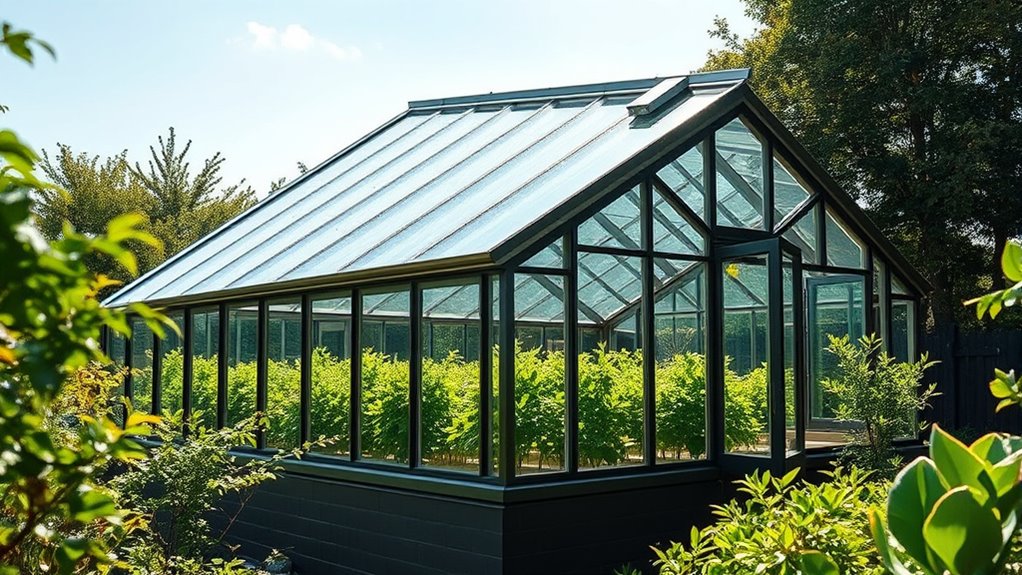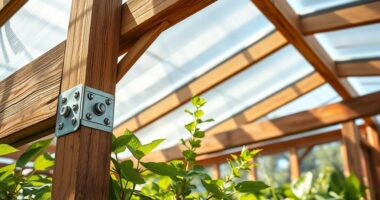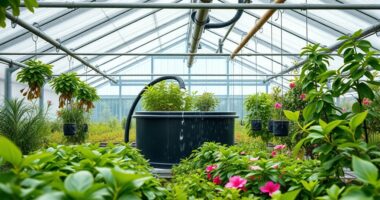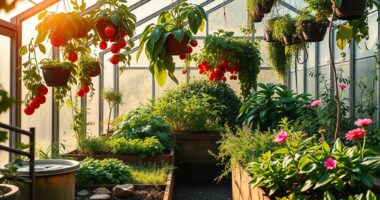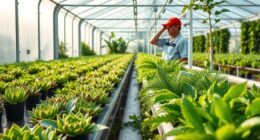To build an energy-efficient greenhouse using passive solar design, focus on maximizing south-facing glazing to absorb winter sunlight while incorporating thermal mass materials like concrete or brick to store heat during the day and release it at night. Proper placement of windows, shading devices, and insulation are key to preventing overheating in summer and retaining warmth in winter. This approach creates a comfortable environment with minimal mechanical intervention. Exploring these combined strategies will help you design a suitable solar greenhouse.
Key Takeaways
- Design the greenhouse with south-facing glazing to maximize winter solar gain and natural light.
- Incorporate high thermal mass materials like concrete or brick floors to store and release heat effectively.
- Use double or triple-glazed windows with low-e coatings for improved insulation and reduced heat loss.
- Install shading devices or overhangs to prevent overheating during summer months while allowing winter sunlight.
- Consider local climate conditions to optimize glazing type, thermal mass placement, and insulation for energy efficiency.
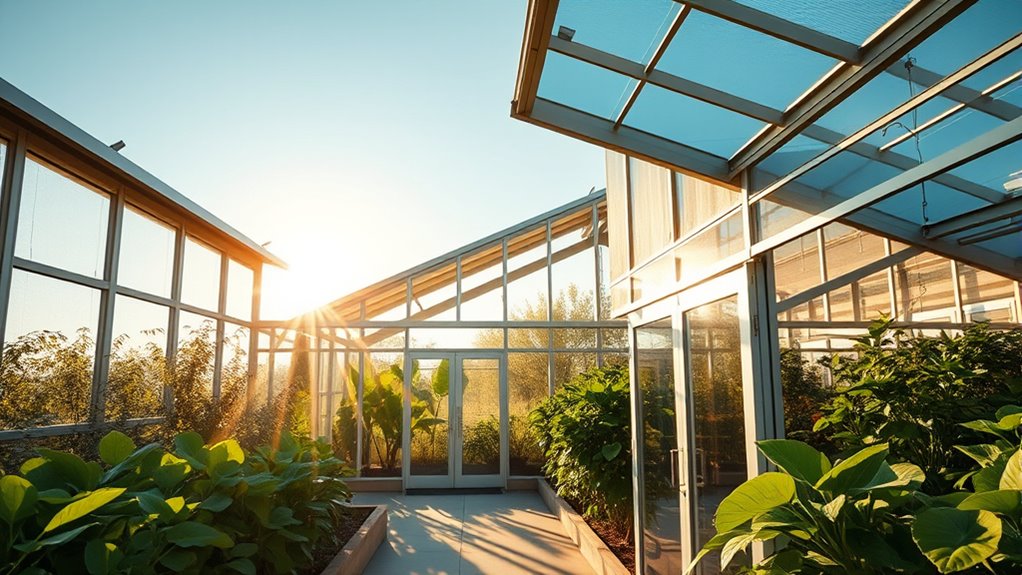
Have you ever wondered how buildings can naturally stay warm in winter and cool in summer without relying heavily on mechanical systems? The secret lies in understanding passive solar design principles, especially how you utilize thermal mass and glazing selection. These elements work together to create a sustainable environment inside your greenhouse, reducing energy consumption and enhancing comfort.
Thermal mass plays a vital role in balancing temperature fluctuations. It absorbs heat during the day when the sun’s rays are strongest and slowly releases that stored heat during cooler nights. By incorporating materials like concrete, brick, or stone into your greenhouse structure, you give it the ability to moderate indoor temperatures naturally. For example, placing a thick concrete floor or interior walls with high thermal mass ensures that daytime heat is stored and gradually released, maintaining a more stable environment. This process minimizes the need for supplemental heating or cooling, making your greenhouse more energy-efficient. When planning your design, think about where to position these materials for maximum exposure to sunlight, and consider their weight and insulation properties to optimize thermal storage.
Glazing selection is equally essential in passive solar design. The type, placement, and size of your greenhouse windows directly influence how much solar energy enters and how well it’s retained. You want glazing that allows ample sunlight to penetrate during winter months when sunlight is weaker, but also minimizes heat loss during colder nights. Double or triple-pane glass, or specialized low-emissivity (low-e) coatings, can help improve insulation without sacrificing light transmission. Positioning large, south-facing windows maximizes solar gain, while shading devices or overhangs can prevent overheating during summer. When choosing glazing, consider the climate of your location—if you face colder winters, prioritize insulation; for warmer climates, focus on shading options to keep temperatures comfortable.
Frequently Asked Questions
What Are the Initial Costs of Passive Solar Greenhouse Construction?
When considering the initial costs of a passive solar greenhouse, you should focus on cost estimation to plan your budget effectively. While construction costs vary based on size and materials, you can explore funding options like grants or loans to offset expenses. Keep in mind that investing in energy-efficient features may have higher upfront costs but can save you money long-term through reduced heating and cooling costs.
How Does Climate Influence Passive Solar Greenhouse Design?
You should consider climate zones and seasonal variations when designing your greenhouse. In colder zones, you’ll need larger thermal mass and better insulation to retain heat, while in milder climates, passive solar features can be more straightforward. Seasonal variations influence your orientation and glazing choices to maximize sunlight in winter and prevent overheating in summer. Adapting your design to your specific climate guarantees energy efficiency and ideal plant growth year-round.
What Maintenance Is Required for Passive Solar Systems?
You need to regularly check your passive solar system for proper system upkeep, like cleaning glass and vents to guarantee ideal energy flow. Seasonal adjustments, such as opening or closing shading devices or vents, help maintain the right temperature. Keep an eye on insulation and structural integrity, especially after harsh weather. Doing these simple maintenance tasks ensures your greenhouse stays energy-efficient year-round and performs at its best.
Can Passive Solar Design Be Integrated With Existing Greenhouses?
Imagine upgrading your current greenhouse to include passive solar features. Yes, passive solar design can be integrated with existing greenhouses, offering great retrofit potential and design flexibility. For example, adding south-facing thermal mass or better insulation enhances energy efficiency without a complete overhaul. You can adapt these passive elements gradually, improving your greenhouse’s sustainability while maintaining its original structure and function.
What Are Common Challenges in Implementing Passive Solar Principles?
When implementing passive solar principles, you often face challenges like properly incorporating thermal mass to store heat and prevent temperature swings. Shading strategies can be tricky, as you need to balance sunlight intake and overheating risks. You might also struggle with designing for seasonal changes and ensuring the greenhouse remains energy-efficient year-round. Addressing these issues requires careful planning and understanding of how thermal mass and shading work together.
Conclusion
By incorporating passive solar design principles, you can create an energy-efficient greenhouse that works with nature rather than against it. This approach not only reduces your reliance on external power sources but also guarantees a sustainable, comfortable environment for your plants. Remember, a well-planned greenhouse is a case of “hitting two birds with one stone”—saving energy and nurturing growth. Embrace these strategies, and you’ll find your greenhouse thrives with minimal effort.
